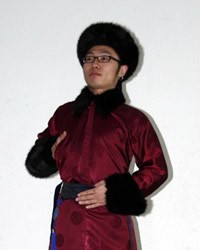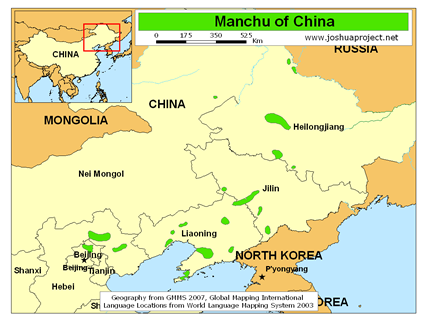Although they are considered China's second largest minority, most Manchu today are indistinguishable from the Han Chinese. As one historian notes, "The Manchus' political and military successes were purchased at the expense of losing their ethnic identity. Long before the Qing Dynasty collapsed in 1911, most Manchus had ceased to be Manchus ethnically, linguistically, and culturally."
The Manchu language is practically extinct. Various studies have listed "less than 20," "70," and "1,000" speakers of Manchu remaining among the entire ethnic group. Manchu speakers are located in a few villages in Heilongjiang - Sanjiazi Village in Fuyu County and Dawujia Village in Aihui County. Most of the Manchu speakers use Mandarin as their first language and speak Manchu "with a pronounced Chinese accent." Manchu was the only Tungus language to possess an orthography, but this too is now extinct.
Although the name Manchu was first used in the early 1600s, their descendants date back 3,000 years to the Suzhen tribe. In 1644 the Manchu broke through the Great Wall and, after several decades of conquest, established the Qing Dynasty which ruled China for 267 years.
All but about 200,000 Manchu have lost their cultural identity. Traditional Manchu dress is now reserved solely for tourist performances.
Before the Manchu were assimilated, they were known as shamanists who also worshiped their ancestors. Some aspects of these practices remain, but today most Manchu are considered nonreligious.
The Catholics commenced work in Manchuria in 1620. By 1922 they numbered 56,000 converts, most of whom were Han Chinese. Protestant work among the Manchu began in 1869. A revival swept through Manchuria in the early 1900s. A blind evangelist, Chang Sen, traveled from village to village winning hundreds of converts to Christ. "Missionaries followed after him, baptizing converts and organizing churches." In the first half of this century many Manchu Christians suffered severe persecution and torture, especially between 1931 and 1945 when northeast China was annexed by Japan and renamed Manchukuo. Today there are at least 10,000 scattered Manchu believers who meet in Chinese churches. Many have come to Christ as the result of the great Heilongjiang revival in the 1990s.
Scripture Prayers for the Manchu in China.
| Profile Source: Operation China, Asia Harvest, et al. |











